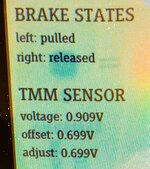I had an interesting issue this morning. It has been ~6 weeks since my last ST2S commute (I don't like riding when snow banks narrow the roads too much). This weekend I took the opportunity to install a longer stem with a -15* angle to get a more aggressive / aero position on the bike. Following the cockpit modifications I did an ~21 mile ride in Mode 2 without any problems.
When I got home, I gently rinsed the bike being careful to stay away from the battery compartment and trying to stay away from where the hub motor plugs in. Given the low temps in my garage, I probably should have spent some more time drying the bike, but I did give it a quick wipe down. This was all on Sat or Sun.
Okay, this morning I took the bike out for my commute. As soon as I pulled out of my driveway, I felt that something was off. I wasn't getting the same level of assist that I was used to, but after cycling through the modes a few times, it seemed to be "ok".
However, about 8 miles later, I lost all assist. I stopped and removed the rear wheel, disconnected wiring harness, reconnected and put everything back together.
The issue seemed "better", but not perfect. The more I rode, the more it seemed like something was off with the torque sensor. If I worked hard (lots of torque), it seemed like I would get assist. Otherwise, not so much. This was primarily in Mode 3 and a little Mode 2.
Finally, I pulled over with a plan to increase torque sensitivity.
I had totally forgotten about the torque calibration.
I performed a cal and cranked up the sensitivity.
That appeared to solve everything.
So - my question for the group: has anyone else had torque sensor issues? Is the sensor particularly susceptible to water? I need to find the torque sensor on the bike so I can attempt to troubleshoot, in the future, as necessary.
When I got home, I gently rinsed the bike being careful to stay away from the battery compartment and trying to stay away from where the hub motor plugs in. Given the low temps in my garage, I probably should have spent some more time drying the bike, but I did give it a quick wipe down. This was all on Sat or Sun.
Okay, this morning I took the bike out for my commute. As soon as I pulled out of my driveway, I felt that something was off. I wasn't getting the same level of assist that I was used to, but after cycling through the modes a few times, it seemed to be "ok".
However, about 8 miles later, I lost all assist. I stopped and removed the rear wheel, disconnected wiring harness, reconnected and put everything back together.
The issue seemed "better", but not perfect. The more I rode, the more it seemed like something was off with the torque sensor. If I worked hard (lots of torque), it seemed like I would get assist. Otherwise, not so much. This was primarily in Mode 3 and a little Mode 2.
Finally, I pulled over with a plan to increase torque sensitivity.
I had totally forgotten about the torque calibration.
I performed a cal and cranked up the sensitivity.
That appeared to solve everything.
So - my question for the group: has anyone else had torque sensor issues? Is the sensor particularly susceptible to water? I need to find the torque sensor on the bike so I can attempt to troubleshoot, in the future, as necessary.





